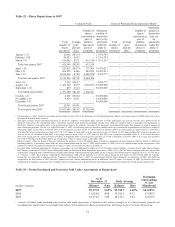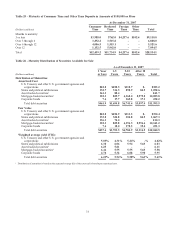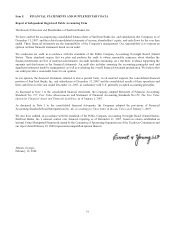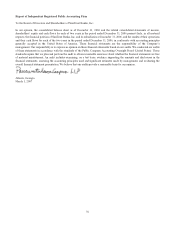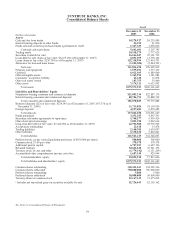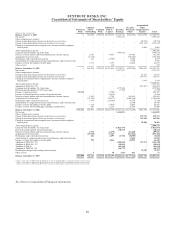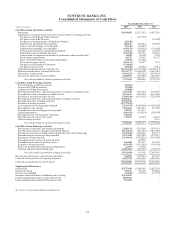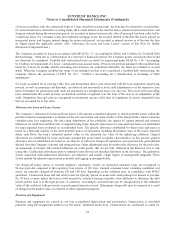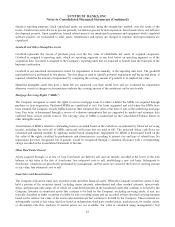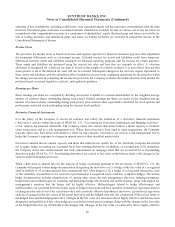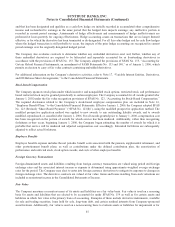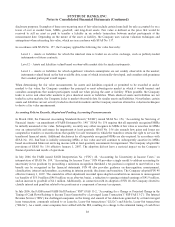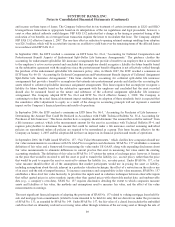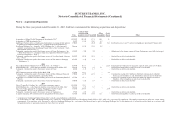SunTrust 2007 Annual Report Download - page 94
Download and view the complete annual report
Please find page 94 of the 2007 SunTrust annual report below. You can navigate through the pages in the report by either clicking on the pages listed below, or by using the keyword search tool below to find specific information within the annual report.SUNTRUST BANKS, INC.
Notes to Consolidated Financial Statements
Note 1 – Significant Accounting Policies
General
SunTrust Banks, Inc. (“SunTrust” or the “Company”) one of the nation’s largest commercial banking organizations, is a
financial services holding company with its headquarters in Atlanta, Georgia. SunTrust’s principal banking subsidiary,
SunTrust Bank, offers a full line of financial services for consumers and businesses through its branches located primarily in
Florida, Georgia, Maryland, North Carolina, South Carolina, Tennessee, Virginia, and the District of Columbia. Within its
geographic footprint, the Company operated under five business segments during 2007. These business segments are: Retail,
Commercial, Corporate and Investment Banking, Wealth and Investment Management, and Mortgage. In addition to
traditional deposit, credit, and trust and investment services offered by SunTrust Bank, other SunTrust subsidiaries provide
mortgage banking, credit-related insurance, asset management, securities brokerage and capital markets services.
Principles of Consolidation and Basis of Presentation
The consolidated financial statements include the accounts of the Company, its majority-owned subsidiaries, and variable
interest entities (“VIEs”) where the Company is the primary beneficiary. All significant intercompany accounts and
transactions have been eliminated. Results of operations of companies purchased are included from the date of acquisition.
Results of operations associated with companies or net assets sold are included through the date of disposition. Assets and
liabilities of purchased companies are stated at estimated fair values at the date of acquisition. Investments in companies
which are not VIEs, or where SunTrust is not the primary beneficiary in a VIE, that the Company owns a voting interest of
20% to 50%, and for which it may have significant influence over operating and financing decisions, are accounted for using
the equity method of accounting. These investments are included in other assets, and the Company’s proportionate share of
income or loss is included in other noninterest income in the Consolidated Statements of Income.
The preparation of financial statements in conformity with accounting principles generally accepted in the United States
(“US GAAP”) requires management to make estimates and assumptions that affect the reported amounts of assets and
liabilities, the disclosure of contingent assets and liabilities at the date of the financial statements and the reported amounts of
revenues and expenses during the reporting period. Actual results could vary from these estimates. Certain reclassifications
have been made to prior period amounts to conform to the current period presentation.
Cash and Cash Equivalents
Cash and cash equivalents include cash and due from banks, interest-bearing deposits in other banks, federal funds sold and
securities purchased under agreements to resell. Generally, cash and cash equivalents have maturities of three months or less,
and accordingly, the carrying amount of these instruments is deemed to be a reasonable estimate of fair value.
Securities and Trading Activities
Securities are classified at trade date as trading or available for sale securities. Securities available for sale are used as part of
the overall asset and liability management process to optimize income and market performance over an entire interest rate
cycle. Interest income and dividends on securities are recognized in interest income on an accrual basis. Premiums and
discounts on debt securities are amortized as an adjustment to yield over the life of the security. Securities available for sale
are carried at fair value with unrealized gains and losses, net of any tax effect, included in accumulated other comprehensive
income as a component of shareholders’ equity. Realized gains and losses on securities are determined using the specific
identification method and are recognized currently in the Consolidated Statements of Income. The Company reviews
available for sale securities for impairment on a quarterly basis. The Company determines whether a decline in fair value
below the amortized cost basis is other-than-temporary. An available for sale security that has been other-than-temporarily
impaired is written down to fair value, and the amount of the write down is accounted for as a realized loss in the
Consolidated Statements of Income. Trading account assets and liabilities are carried at fair value. Realized and unrealized
gains and losses are determined using the specific identification method and are recognized as a component of noninterest
income in the Consolidated Statements of Income.
82


